"How do I do paid growth for newsletters?"
This is one of the most popular questions we heard while researching the Newsletter Guide.
So we interviewed our growth team @theHustle, plus experts from all over.
Let me break down what we found...
This is one of the most popular questions we heard while researching the Newsletter Guide.
So we interviewed our growth team @theHustle, plus experts from all over.
Let me break down what we found...
Over and over we heard the same thing from growth experts:
"When it comes to paid growth, the MOST important thing is understanding your Target Cost Per Acquisition (CPA)."
No matter where you& #39;re advertising, knowing your Target CPA is crucial to success.
"When it comes to paid growth, the MOST important thing is understanding your Target Cost Per Acquisition (CPA)."
No matter where you& #39;re advertising, knowing your Target CPA is crucial to success.
To figure out your Target CPA, you need 2 things:
 https://abs.twimg.com/emoji/v2/... draggable="false" alt="1️⃣" title="Tastenkappe Ziffer 1" aria-label="Emoji: Tastenkappe Ziffer 1"> The lifetime value of your readers (CLTV)
https://abs.twimg.com/emoji/v2/... draggable="false" alt="1️⃣" title="Tastenkappe Ziffer 1" aria-label="Emoji: Tastenkappe Ziffer 1"> The lifetime value of your readers (CLTV)
 https://abs.twimg.com/emoji/v2/... draggable="false" alt="2️⃣" title="Tastenkappe Ziffer 2" aria-label="Emoji: Tastenkappe Ziffer 2"> Your desired profit margin or pay-back period
https://abs.twimg.com/emoji/v2/... draggable="false" alt="2️⃣" title="Tastenkappe Ziffer 2" aria-label="Emoji: Tastenkappe Ziffer 2"> Your desired profit margin or pay-back period
Buckle up... we& #39;re gonna explore math in tweet form (apologies in advance).
Buckle up... we& #39;re gonna explore math in tweet form (apologies in advance).
Let& #39;s start with CLTV.
In a normal business, CLTV is simple -- it& #39;s just the amount of money you can expect to make from a customer.
Let& #39;s say you sell a widget for $1k. Each customer buys only 1.
That means each customer is worth $1k to the business. Their CLTV is $1k.
In a normal business, CLTV is simple -- it& #39;s just the amount of money you can expect to make from a customer.
Let& #39;s say you sell a widget for $1k. Each customer buys only 1.
That means each customer is worth $1k to the business. Their CLTV is $1k.
Newsletters aren& #39;t much different.
You& #39;re calculating how much you earn from each reader, based on:
 https://abs.twimg.com/emoji/v2/... draggable="false" alt="1️⃣" title="Tastenkappe Ziffer 1" aria-label="Emoji: Tastenkappe Ziffer 1"> Revenue per Engagement
https://abs.twimg.com/emoji/v2/... draggable="false" alt="1️⃣" title="Tastenkappe Ziffer 1" aria-label="Emoji: Tastenkappe Ziffer 1"> Revenue per Engagement
 https://abs.twimg.com/emoji/v2/... draggable="false" alt="2️⃣" title="Tastenkappe Ziffer 2" aria-label="Emoji: Tastenkappe Ziffer 2"> Engagement Rates
https://abs.twimg.com/emoji/v2/... draggable="false" alt="2️⃣" title="Tastenkappe Ziffer 2" aria-label="Emoji: Tastenkappe Ziffer 2"> Engagement Rates
 https://abs.twimg.com/emoji/v2/... draggable="false" alt="3️⃣" title="Tastenkappe Ziffer 3" aria-label="Emoji: Tastenkappe Ziffer 3"> Length of Subscriber Lifetime
https://abs.twimg.com/emoji/v2/... draggable="false" alt="3️⃣" title="Tastenkappe Ziffer 3" aria-label="Emoji: Tastenkappe Ziffer 3"> Length of Subscriber Lifetime
Let& #39;s break these down...
You& #39;re calculating how much you earn from each reader, based on:
Let& #39;s break these down...
For example, a newsletter might charge advertisers based on:
-Cost Per Send (CPS)
-Cost Per Open (CPO)
-Cost Per Click (CPC)
Therefor, each send, open, or click is worth money
For this thread, let& #39;s assume you charge advertisers based on the number of people who open the email (CPO)
If you charge $50 per thousand opens:
$50 / 1,000 = $0.05 per open
So every time a reader opens your email, you get a nickel.
If you charge $50 per thousand opens:
$50 / 1,000 = $0.05 per open
So every time a reader opens your email, you get a nickel.
Let& #39;s say after a few months you find an average reader opens half of your emails.
If you send 5 days a week, then you would expect them to open ~10 emails per month (~$0.50 in earnings).
As you can see, this means the value of a reader keeps going up the longer they stay subscribed and reading.
Cumulative Income:
Month 1 - $0.50
Month 2 - $1.00
Month 3 - $1.50
etc...
But readers don& #39;t stay forever. So we estimate how long they stick around...
Cumulative Income:
Month 1 - $0.50
Month 2 - $1.00
Month 3 - $1.50
etc...
But readers don& #39;t stay forever. So we estimate how long they stick around...
Let& #39;s say you find that most readers stick around for about a year and a half before eventually unsubscribing.
That& #39;s ~350-400 sends at 5 days per week.
The last step is to combine these 3 to calculate your CLTV:
 https://abs.twimg.com/emoji/v2/... draggable="false" alt="1️⃣" title="Tastenkappe Ziffer 1" aria-label="Emoji: Tastenkappe Ziffer 1"> Revenue per Open = $0.05
https://abs.twimg.com/emoji/v2/... draggable="false" alt="1️⃣" title="Tastenkappe Ziffer 1" aria-label="Emoji: Tastenkappe Ziffer 1"> Revenue per Open = $0.05
 https://abs.twimg.com/emoji/v2/... draggable="false" alt="2️⃣" title="Tastenkappe Ziffer 2" aria-label="Emoji: Tastenkappe Ziffer 2"> Open Rates = 50%
https://abs.twimg.com/emoji/v2/... draggable="false" alt="2️⃣" title="Tastenkappe Ziffer 2" aria-label="Emoji: Tastenkappe Ziffer 2"> Open Rates = 50%
 https://abs.twimg.com/emoji/v2/... draggable="false" alt="3️⃣" title="Tastenkappe Ziffer 3" aria-label="Emoji: Tastenkappe Ziffer 3"> Subscriber Lifetime = ~400 sends
https://abs.twimg.com/emoji/v2/... draggable="false" alt="3️⃣" title="Tastenkappe Ziffer 3" aria-label="Emoji: Tastenkappe Ziffer 3"> Subscriber Lifetime = ~400 sends
400 sends x 50% opened = 200 emails opened.
200 x $0.05 = $10 earned.
Your CLTV is $10.
400 sends x 50% opened = 200 emails opened.
200 x $0.05 = $10 earned.
Your CLTV is $10.
Now that you know how much you expect to earn, you need to decide how much you& #39;re willing to pay to acquire that reader (this is your Target CPA).
To do that, you consider 2 things:
 https://abs.twimg.com/emoji/v2/... draggable="false" alt="🗓️" title="Spiralkalenderblatt" aria-label="Emoji: Spiralkalenderblatt"> Your desired payback period
https://abs.twimg.com/emoji/v2/... draggable="false" alt="🗓️" title="Spiralkalenderblatt" aria-label="Emoji: Spiralkalenderblatt"> Your desired payback period
 https://abs.twimg.com/emoji/v2/... draggable="false" alt="🤑" title="Gesicht mit Geld-Mund" aria-label="Emoji: Gesicht mit Geld-Mund"> Your target profit margin
https://abs.twimg.com/emoji/v2/... draggable="false" alt="🤑" title="Gesicht mit Geld-Mund" aria-label="Emoji: Gesicht mit Geld-Mund"> Your target profit margin
To do that, you consider 2 things:
It& #39;s crucial because you need that money in order to keep growing/paying the bills.
There& #39;s no rule for this, but 6-12 months is common.
Again, no rule, but it& #39;s common to target 100% or more.
You& #39;re constantly balancing these 2 forces when setting paid growth goals.
If you& #39;re willing to take a longer payback period https://abs.twimg.com/emoji/v2/... draggable="false" alt="🗓️" title="Spiralkalenderblatt" aria-label="Emoji: Spiralkalenderblatt">, or lower profit margin
https://abs.twimg.com/emoji/v2/... draggable="false" alt="🗓️" title="Spiralkalenderblatt" aria-label="Emoji: Spiralkalenderblatt">, or lower profit margin  https://abs.twimg.com/emoji/v2/... draggable="false" alt="🤑" title="Gesicht mit Geld-Mund" aria-label="Emoji: Gesicht mit Geld-Mund">, you can spend more on acquisition and grow faster.
https://abs.twimg.com/emoji/v2/... draggable="false" alt="🤑" title="Gesicht mit Geld-Mund" aria-label="Emoji: Gesicht mit Geld-Mund">, you can spend more on acquisition and grow faster.
If you& #39;re willing to take a longer payback period
So, you have your Target CPA... Now what?
Test, test, test.
Most people want to know the BEST way to grow. The truth is, there isn& #39;t one.
Your growth will depend on your industry, audience, budget, goals, etc...
But there are a few industry standards...
Test, test, test.
Most people want to know the BEST way to grow. The truth is, there isn& #39;t one.
Your growth will depend on your industry, audience, budget, goals, etc...
But there are a few industry standards...
You can learn a lot about your ideal audience, then use that information to test other platforms more effectively.
You can spy on competitors& #39; ads with FB& #39;s ad library: https://www.facebook.com/ads/library ">https://www.facebook.com/ads/libra...
You really need to understand your keywords, and search intent to be successful there.
The best resource I& #39;ve seen on understanding search intent is @stephsmithio& #39;s book: https://doingcontentright.com/ ">https://doingcontentright.com/">...
Morning Brew, for example, drives considerable traffic each month from YouTube, and is ramping up their influencer budget.
No matter which method you choose, your Target CPA is your guiding light.
You& #39;re always trying to get *high quality* subscribers at or below Target CPA. So test everything.
Quality is crucial, and worth talking about for a second...
You& #39;re always trying to get *high quality* subscribers at or below Target CPA. So test everything.
Quality is crucial, and worth talking about for a second...
There are lots of possible growth methods. Not all of them result in quality subscribers.
For example, giveaways can bring in lots of signups.
But if people only care about the giveaway, they may never open the email after they sign up. Money wasted. No bueno...
For example, giveaways can bring in lots of signups.
But if people only care about the giveaway, they may never open the email after they sign up. Money wasted. No bueno...
As your growth program evolves, you may account for different levels of readers. For example:
Low Quality Subscribers - 10% open rate
Average Subscribers - 50% open rate
High Quality Subscribers - 80% open rate
Each have their own CLTV, and by extension, their own Target CPA.
Low Quality Subscribers - 10% open rate
Average Subscribers - 50% open rate
High Quality Subscribers - 80% open rate
Each have their own CLTV, and by extension, their own Target CPA.
I& #39;m preparing a talk on this, so feel free to DM questions if you like.
I& #39;m also joining @davenemetz, @janelSGM, and @danshipper to talk more about growing and monetizing newsletters.
Come hang with us!
https://protect-us.mimecast.com/s/6Dk4C1wMm9cZz8PJSLzlIl?domain=lu.ma">https://protect-us.mimecast.com/s/6Dk4C1w... https://twitter.com/davenemetz/status/1384585708543913984">https://twitter.com/davenemet...
I& #39;m also joining @davenemetz, @janelSGM, and @danshipper to talk more about growing and monetizing newsletters.
Come hang with us!
https://protect-us.mimecast.com/s/6Dk4C1wMm9cZz8PJSLzlIl?domain=lu.ma">https://protect-us.mimecast.com/s/6Dk4C1w... https://twitter.com/davenemetz/status/1384585708543913984">https://twitter.com/davenemet...

 Read on Twitter
Read on Twitter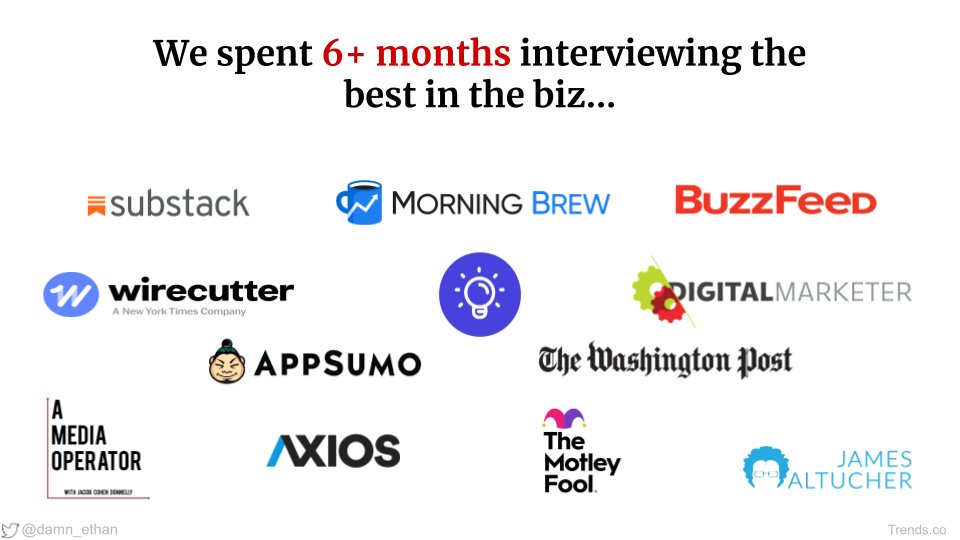
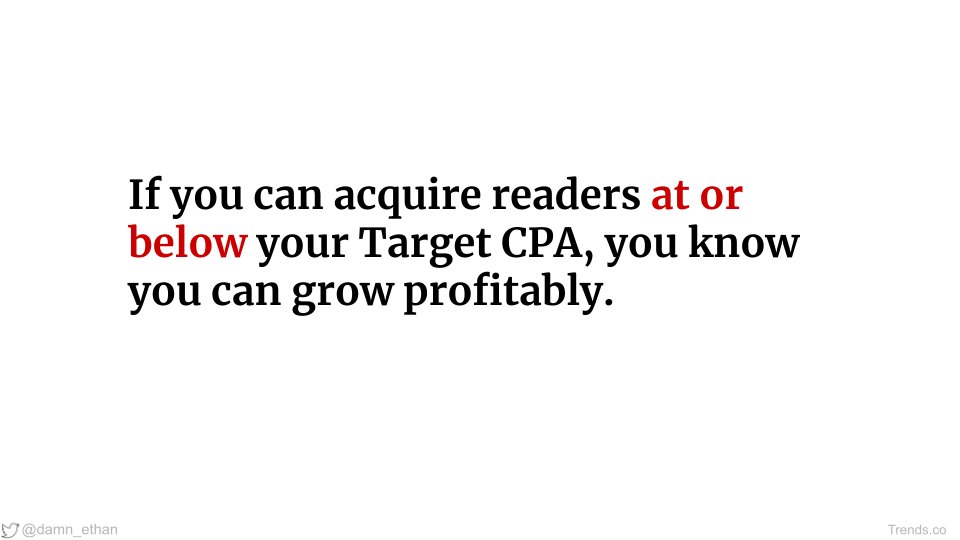


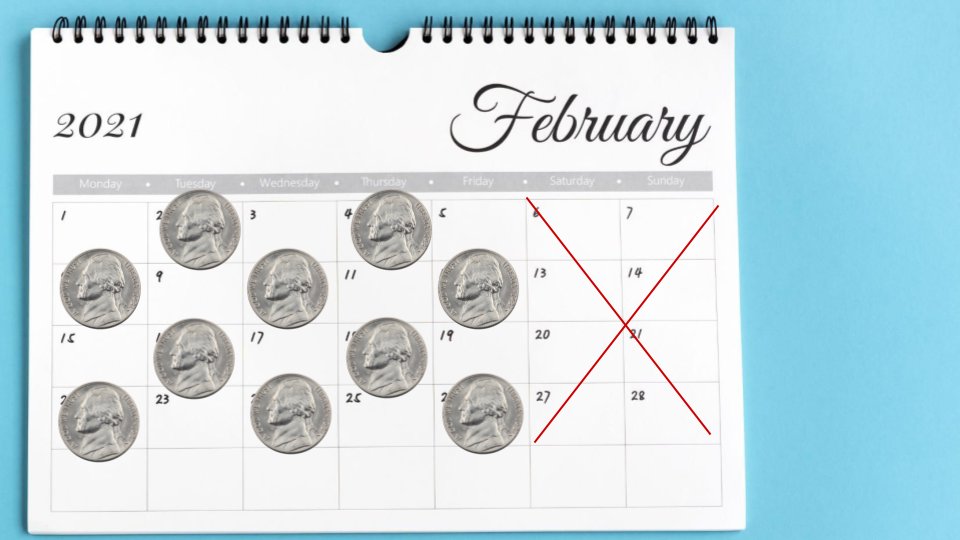 Engagement RatesLet& #39;s say after a few months you find an average reader opens half of your emails.If you send 5 days a week, then you would expect them to open ~10 emails per month (~$0.50 in earnings)." title="https://abs.twimg.com/emoji/v2/... draggable="false" alt="2️⃣" title="Tastenkappe Ziffer 2" aria-label="Emoji: Tastenkappe Ziffer 2"> Engagement RatesLet& #39;s say after a few months you find an average reader opens half of your emails.If you send 5 days a week, then you would expect them to open ~10 emails per month (~$0.50 in earnings)." class="img-responsive" style="max-width:100%;"/>
Engagement RatesLet& #39;s say after a few months you find an average reader opens half of your emails.If you send 5 days a week, then you would expect them to open ~10 emails per month (~$0.50 in earnings)." title="https://abs.twimg.com/emoji/v2/... draggable="false" alt="2️⃣" title="Tastenkappe Ziffer 2" aria-label="Emoji: Tastenkappe Ziffer 2"> Engagement RatesLet& #39;s say after a few months you find an average reader opens half of your emails.If you send 5 days a week, then you would expect them to open ~10 emails per month (~$0.50 in earnings)." class="img-responsive" style="max-width:100%;"/>
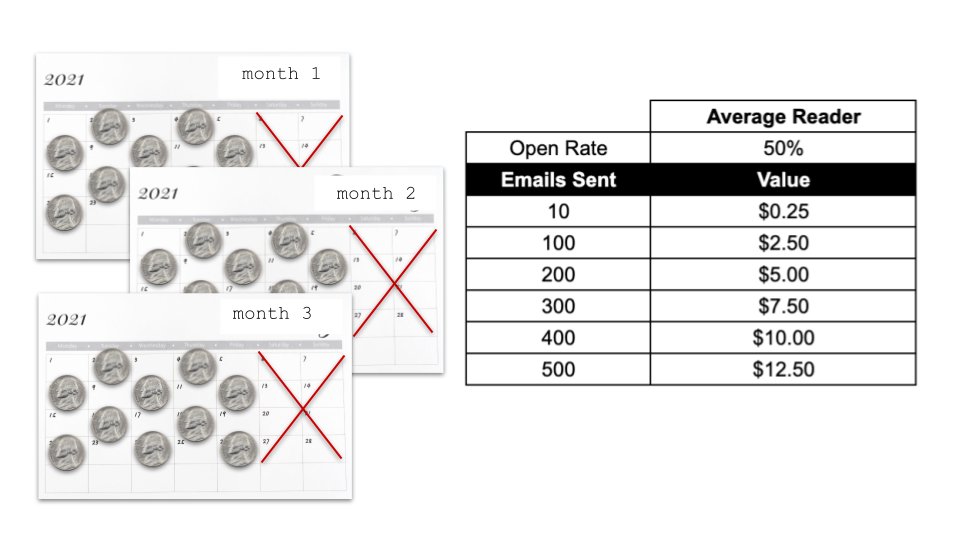
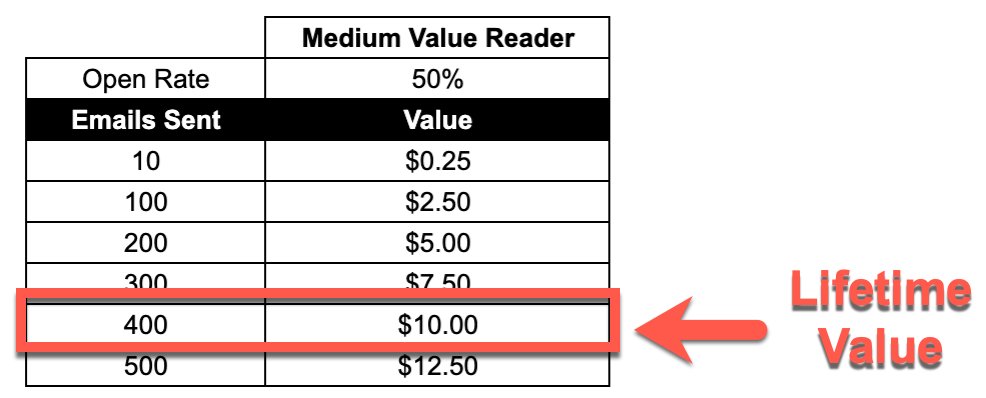 Revenue per Open = $0.05https://abs.twimg.com/emoji/v2/... draggable="false" alt="2️⃣" title="Tastenkappe Ziffer 2" aria-label="Emoji: Tastenkappe Ziffer 2"> Open Rates = 50%https://abs.twimg.com/emoji/v2/... draggable="false" alt="3️⃣" title="Tastenkappe Ziffer 3" aria-label="Emoji: Tastenkappe Ziffer 3"> Subscriber Lifetime = ~400 sends400 sends x 50% opened = 200 emails opened.200 x $0.05 = $10 earned.Your CLTV is $10." title="The last step is to combine these 3 to calculate your CLTV:https://abs.twimg.com/emoji/v2/... draggable="false" alt="1️⃣" title="Tastenkappe Ziffer 1" aria-label="Emoji: Tastenkappe Ziffer 1"> Revenue per Open = $0.05https://abs.twimg.com/emoji/v2/... draggable="false" alt="2️⃣" title="Tastenkappe Ziffer 2" aria-label="Emoji: Tastenkappe Ziffer 2"> Open Rates = 50%https://abs.twimg.com/emoji/v2/... draggable="false" alt="3️⃣" title="Tastenkappe Ziffer 3" aria-label="Emoji: Tastenkappe Ziffer 3"> Subscriber Lifetime = ~400 sends400 sends x 50% opened = 200 emails opened.200 x $0.05 = $10 earned.Your CLTV is $10." class="img-responsive" style="max-width:100%;"/>
Revenue per Open = $0.05https://abs.twimg.com/emoji/v2/... draggable="false" alt="2️⃣" title="Tastenkappe Ziffer 2" aria-label="Emoji: Tastenkappe Ziffer 2"> Open Rates = 50%https://abs.twimg.com/emoji/v2/... draggable="false" alt="3️⃣" title="Tastenkappe Ziffer 3" aria-label="Emoji: Tastenkappe Ziffer 3"> Subscriber Lifetime = ~400 sends400 sends x 50% opened = 200 emails opened.200 x $0.05 = $10 earned.Your CLTV is $10." title="The last step is to combine these 3 to calculate your CLTV:https://abs.twimg.com/emoji/v2/... draggable="false" alt="1️⃣" title="Tastenkappe Ziffer 1" aria-label="Emoji: Tastenkappe Ziffer 1"> Revenue per Open = $0.05https://abs.twimg.com/emoji/v2/... draggable="false" alt="2️⃣" title="Tastenkappe Ziffer 2" aria-label="Emoji: Tastenkappe Ziffer 2"> Open Rates = 50%https://abs.twimg.com/emoji/v2/... draggable="false" alt="3️⃣" title="Tastenkappe Ziffer 3" aria-label="Emoji: Tastenkappe Ziffer 3"> Subscriber Lifetime = ~400 sends400 sends x 50% opened = 200 emails opened.200 x $0.05 = $10 earned.Your CLTV is $10." class="img-responsive" style="max-width:100%;"/>
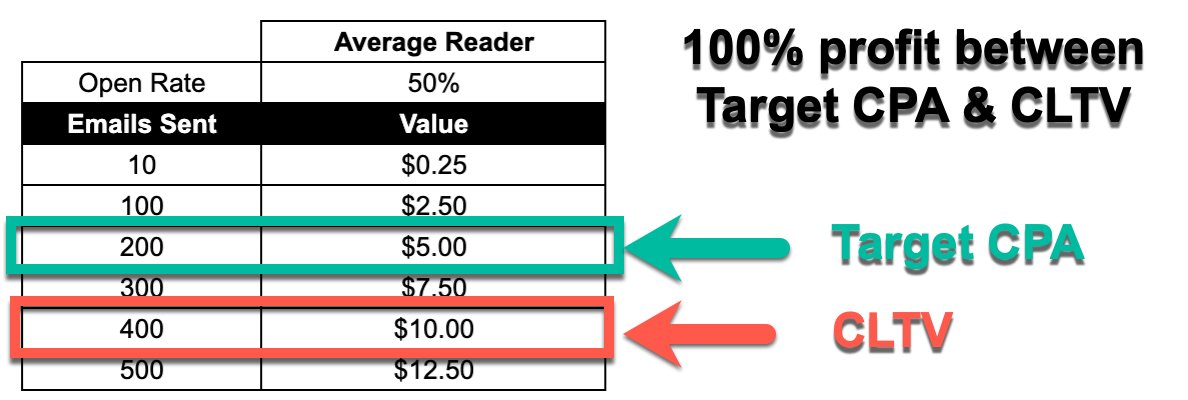 Your target profit margin is how much profit you& #39;d like to earn on a reader during their projected lifetime.Again, no rule, but it& #39;s common to target 100% or more." title="https://abs.twimg.com/emoji/v2/... draggable="false" alt="🤑" title="Gesicht mit Geld-Mund" aria-label="Emoji: Gesicht mit Geld-Mund"> Your target profit margin is how much profit you& #39;d like to earn on a reader during their projected lifetime.Again, no rule, but it& #39;s common to target 100% or more." class="img-responsive" style="max-width:100%;"/>
Your target profit margin is how much profit you& #39;d like to earn on a reader during their projected lifetime.Again, no rule, but it& #39;s common to target 100% or more." title="https://abs.twimg.com/emoji/v2/... draggable="false" alt="🤑" title="Gesicht mit Geld-Mund" aria-label="Emoji: Gesicht mit Geld-Mund"> Your target profit margin is how much profit you& #39;d like to earn on a reader during their projected lifetime.Again, no rule, but it& #39;s common to target 100% or more." class="img-responsive" style="max-width:100%;"/>
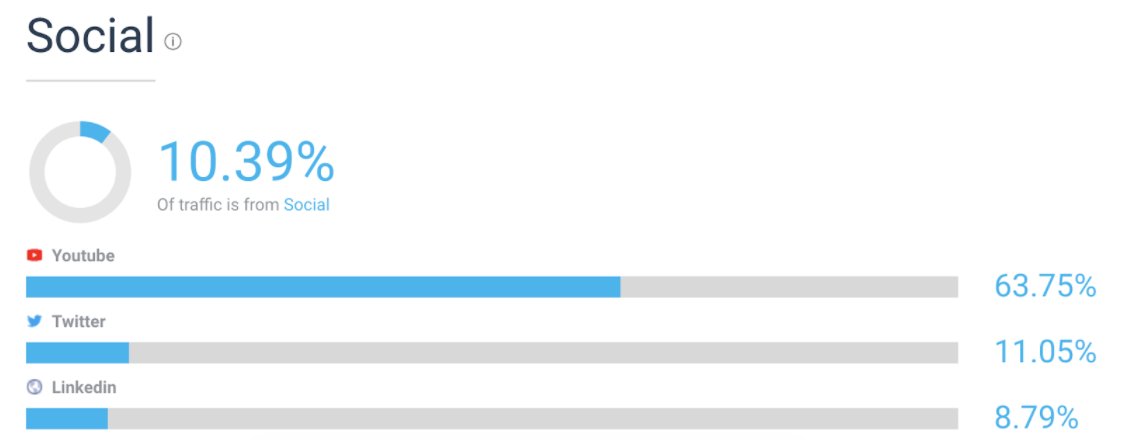 Influencer marketing is still a huge opportunity.Morning Brew, for example, drives considerable traffic each month from YouTube, and is ramping up their influencer budget." title="https://abs.twimg.com/emoji/v2/... draggable="false" alt="3️⃣" title="Tastenkappe Ziffer 3" aria-label="Emoji: Tastenkappe Ziffer 3"> Influencer marketing is still a huge opportunity.Morning Brew, for example, drives considerable traffic each month from YouTube, and is ramping up their influencer budget.">
Influencer marketing is still a huge opportunity.Morning Brew, for example, drives considerable traffic each month from YouTube, and is ramping up their influencer budget." title="https://abs.twimg.com/emoji/v2/... draggable="false" alt="3️⃣" title="Tastenkappe Ziffer 3" aria-label="Emoji: Tastenkappe Ziffer 3"> Influencer marketing is still a huge opportunity.Morning Brew, for example, drives considerable traffic each month from YouTube, and is ramping up their influencer budget.">
 Influencer marketing is still a huge opportunity.Morning Brew, for example, drives considerable traffic each month from YouTube, and is ramping up their influencer budget." title="https://abs.twimg.com/emoji/v2/... draggable="false" alt="3️⃣" title="Tastenkappe Ziffer 3" aria-label="Emoji: Tastenkappe Ziffer 3"> Influencer marketing is still a huge opportunity.Morning Brew, for example, drives considerable traffic each month from YouTube, and is ramping up their influencer budget.">
Influencer marketing is still a huge opportunity.Morning Brew, for example, drives considerable traffic each month from YouTube, and is ramping up their influencer budget." title="https://abs.twimg.com/emoji/v2/... draggable="false" alt="3️⃣" title="Tastenkappe Ziffer 3" aria-label="Emoji: Tastenkappe Ziffer 3"> Influencer marketing is still a huge opportunity.Morning Brew, for example, drives considerable traffic each month from YouTube, and is ramping up their influencer budget.">



